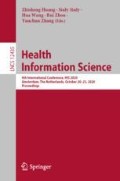Abstract
Following the rapid advances of the human microbiome, the importance of micro-organisms especially bacteria is gradually recognized. The interactions among bacteria and their host are particulary important for understanding the mechanism of microbe-relate diseases. This article mainly introduces an explorative study to extract the relations between bacteria and diseases based on biomedical text mining. We have constructed a Microbe-Disease Knowledge Graph (MDKG) through integrating multi-source heterogeneous data from Wikipedia text and other related databases. Specifically, we introduce the word embedding obtained from biomedical literature into traditional method. Results show that the pre-trained relation vectors can better represent the real associations between entities. Therefore, the construction of MDKG can also provide a new way to predict and analyse the associations between microbes and diseases based on text mining.
Access this chapter
Tax calculation will be finalised at checkout
Purchases are for personal use only
References
Turnbaugh, P.J., Ley, R.E., Hamady, M., Fraserliggett, C.M., Knight, R., Gordon, J.I.: The human microbiome project. Nature 449(7164), 804–810 (2007)
Zhao, L., et al.: Gut bacteria selectively promoted by dietary fibers alleviate type 2 diabetes. Science 359(6380), 1151–1156 (2018)
Grenham, S., Clarke, G., Cryan, J.F., Dinan, T.G.: Brain-gut-microbe communication in health and disease. Front. Physiol. 2, 94–94 (2011)
Lever, J., Zhao, E.Y., Grewal, J.K., Jones, M.R., Jones, S.J.M.: CancerMine: a literature-mined resource for drivers, oncogenes and tumor suppressors in cancer. Nat. Methods 16(6), 505–507 (2019)
Lu, Y., Guo, Y., Korhonen, A.: Link prediction in drug-target interactions network using similarity indices. BMC Bioinformatics 18(1), 39–39 (2017)
Ma, W., Huang, C., Zhou, Y., Li, J., Cui, Q.: MicroPattern: a web-based tool for microbe set enrichment analysis and disease similarity calculation based on a list of microbes. Sci. Rep. 7(1), 40200–40200 (2017)
Ma, W., et al.: An analysis of human microbe-disease associations. Briefings Bioinformatics 18(1), 85–97 (2017)
Janssens, Y., et al.: Disbiome database: linking the microbiome to disease. BMC Microbiol. 18(1), 50–50 (2018)
Li, X., Fu, C., Zhong, R., Zhong, D., He, T., Jiang, X.: A hybrid deep learning framework for bacterial named entity recognition with domain features. BMC Bioinformatics 20(16), 1–9 (2019)
Badal, V.D., et al.: Challenges in the construction of knowledge bases for human microbiome-disease associations. Microbiome 7(1), 129 (2019)
Zinovyev, A., Czerwinska, U., Cantini, L., Barillot, E., Frahm, K.M., Shepelyansky, D.L.: Collective intelligence defines biological functions in Wikipedia as communities in the hidden protein connection network. bioRxiv, p. 618447 (2019)
Rollin, G., Lages, J., Shepelyansky, D.L.: World influence of infectious diseases from Wikipedia network analysis. IEEE Access 7, 26073–26087 (2019)
Kwon, S., Yoon, S.: End-to-end representation learning for chemical-chemical interaction prediction. IEEE/ACM Trans. Comput. Biol. Bioinf. 16(5), 1436–1447 (2019)
Malas, T.B., et al.: Drug prioritization using the semantic properties of a knowledge graph. Sci. Rep. 9(1), 6281 (2019)
Yu, T., et al.: Knowledge graph for TCM health preservation: design, construction, and applications. Artif. Intell. Med. 77, 48–52 (2017)
Nickel, M., Tresp, V., Kriegel, H.: A three-way model for collective learning on multi-relational data. In: International Conference on Machine Learning, pp. 809–816 (2011)
Yang, B., Yih, W., He, X., Gao, J., Deng, L.: Embedding entities and relations for learning and inference in knowledge bases. arXiv : Computation and Language (2014)
Hayashi, K., Shimbo, M.: On the equivalence of holographic and complex embeddings for link prediction. arXiv : Learning (2017)
Liu, H., Wu, Y., Yang, Y.: Analogical inference for multi-relational embeddings. arXiv : Learning (2017)
Schlichtkrull, M.S., Kipf, T., Bloem, P., Den Berg, R.V., Titov, I., Welling, M.: Modeling relational data with graph convolutional networks. In: European Semantic Web Conference, pp. 593–607 (2018)
Bordes, A., Usunier, N., Garciaduran, A., Weston, J., Yakhnenko, O.: Translating embeddings for modeling multi-relational data. In: Neural Information Processing Systems, pp. 2787–2795 (2013)
Mikolov, T., Chen, K., Corrado, G., Dean, J.: Efficient estimation of word representations in vector space. Computer Science (2013)
Chapelle, O., Metlzer, D., Zhang, Y., Grinspan, P.: Expected reciprocal rank for graded relevance. In: Conference on Information and Knowledge Management, pp. 621–630 (2009)
Acknowledgement
This research is supported by National Key Research and Development Program of China (2017YFC0909502) and the National Natural Science Foundation of China (61532008 and 61872157). We also thanks to the support of Fundamental Research Funds for Central Universities (CCNU19ZN009).
Author information
Authors and Affiliations
Corresponding author
Editor information
Editors and Affiliations
Rights and permissions
Copyright information
© 2020 Springer Nature Switzerland AG
About this paper
Cite this paper
Fu, C., Zhong, R., Jiang, X., He, T., Jiang, X. (2020). An Integrated Knowledge Graph for Microbe-Disease Associations. In: Huang, Z., Siuly, S., Wang, H., Zhou, R., Zhang, Y. (eds) Health Information Science. HIS 2020. Lecture Notes in Computer Science(), vol 12435. Springer, Cham. https://doi.org/10.1007/978-3-030-61951-0_8
Download citation
DOI: https://doi.org/10.1007/978-3-030-61951-0_8
Published:
Publisher Name: Springer, Cham
Print ISBN: 978-3-030-61950-3
Online ISBN: 978-3-030-61951-0
eBook Packages: Computer ScienceComputer Science (R0)

